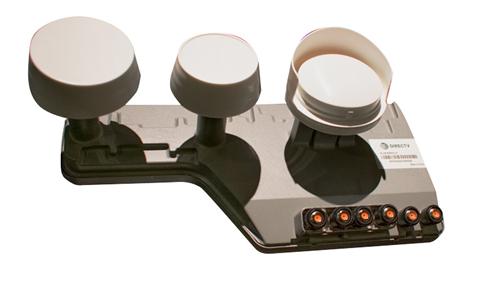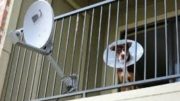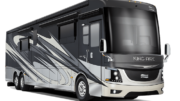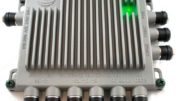This Reverse Band 5 Legacy LNB for DIRECTV is the best, baddest LNB ever made for DIRECTV service. It’s also the biggest. Blame all the many different electronics inside it. This one device is capable of picking up three different frequency ranges from five different locations, in two polarities. That’s a lot for it to do.
Most folks don’t need something that big and fancy. Even if you see 4K in your future you probably only need a Reverse Band 3 LNB which is smaller and much easier to wire. Commercial installations use this LNB to get virtually unlimited receivers from one dish, but the Reverse Band 3 will reliably handle up to 13 tuners – which translates out to an HR54 Genie, two HR24 DVRs, two receivers, and three clients. Or, you an use it to run a Genie 2 and its 7 clients. If you can’t get it done with 7 or 8 rooms, there are options but most folks will definitely be able to “settle” for 8 rooms of DIRECTV service.
Why so many wires?
Connecting this LNB takes six wires. Connecting up your average LNB for home use takes only one. The difference is that the typical home LNB uses the “SWM” system to put all the signals from all the satellites on one line. When you use a legacy LNB, the SWM multiswitch isn’t built in. You run all the wires to an external multiswitch. This makes the system more expandable, but it’s also harder to wire.
A legacy LNB uses four wires for the four main types of signals and two more wires for 4K signals. That ends up being a lot of wiring and probably not something you would want to do unless you really felt like you needed to. The Reverse Band 3 LNB does 4K, so that’s not the issue. In fact…
Is there a reason to use this LNB for home?
Until 2023, this LNB was used whenever a customer needed international channels. DIRECTV has packages for people who speak Russian, Korean, international Spanish, and other languages. For most of DIRECTV’s time in existence, those channels were on a separate satellite. You needed a separate dish to receive them. You used the legacy LNB with its six wires, plus a seventh wire for the international dish, and wired them all up into a multiswitch.
Luckily, that’s not the case now. All of DIRECTV’s content, including international channels, can be found from just DIRECTV’s three primary satellite locations.
Let’s talk for a second about those two extra satellite locations
The Legacy LNB has three white feed horns on it. The rightmost one in the picture at top, that’s for the three satellite locations that are in actual use. The other two are for DIRECTV’s former location at 110 degrees, and for the 119 degree location which DIRECTV is rapidly moving away from.
They could come up with an LNB that only saw those three primary locations, but it would still require six cables. At the moment, there are enough of the current legacy LNBs in the pipeline to satisfy demand. If that changes, they may just come up with a new dish.
If you just love TV…
You can use the legacy dish and as many SWM-30 multiswitches as you want to get the ultimate DIRECTV system. Each SWM-30 can support two banks of 13 tuners each which can all share programming with each other. You could very easily scale this up to over 100 receivers if you wanted to.
One last thing:
You’ll notice that I talk about “tuners” not “receivers” because they’re not the same thing. When you’re deciding how to build a large DIRECTV system you have to count tuners. Luckily, here’s a great tutorial on just how to do that.
If you want to know more about upgrading your home or business satellite system, call the experts at 888-233-7563. We’re here during East Coast business hours. If it’s after hours, no problem! Fill out the form below and we’ll get right back to you.





